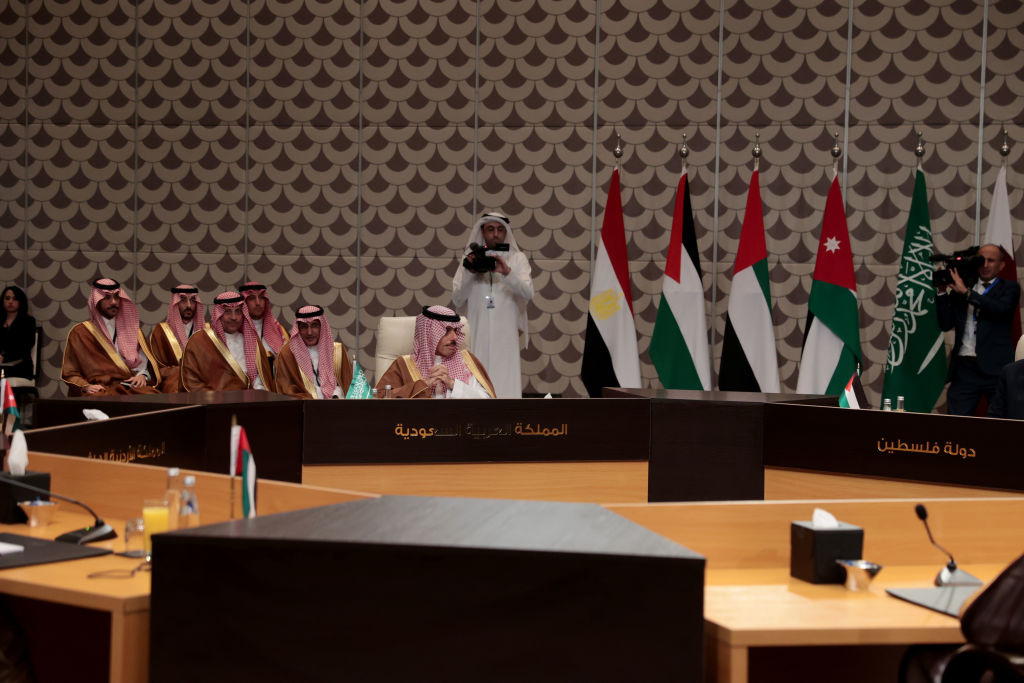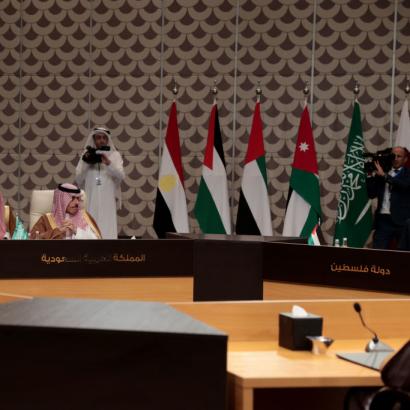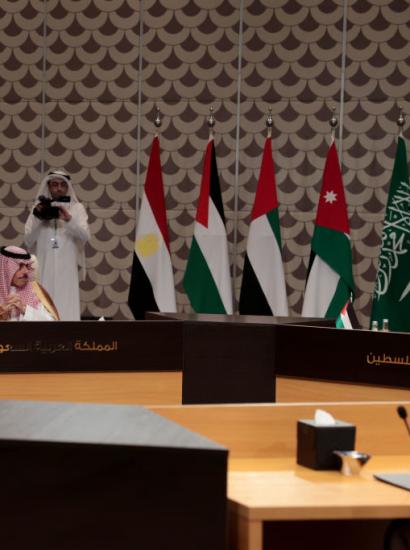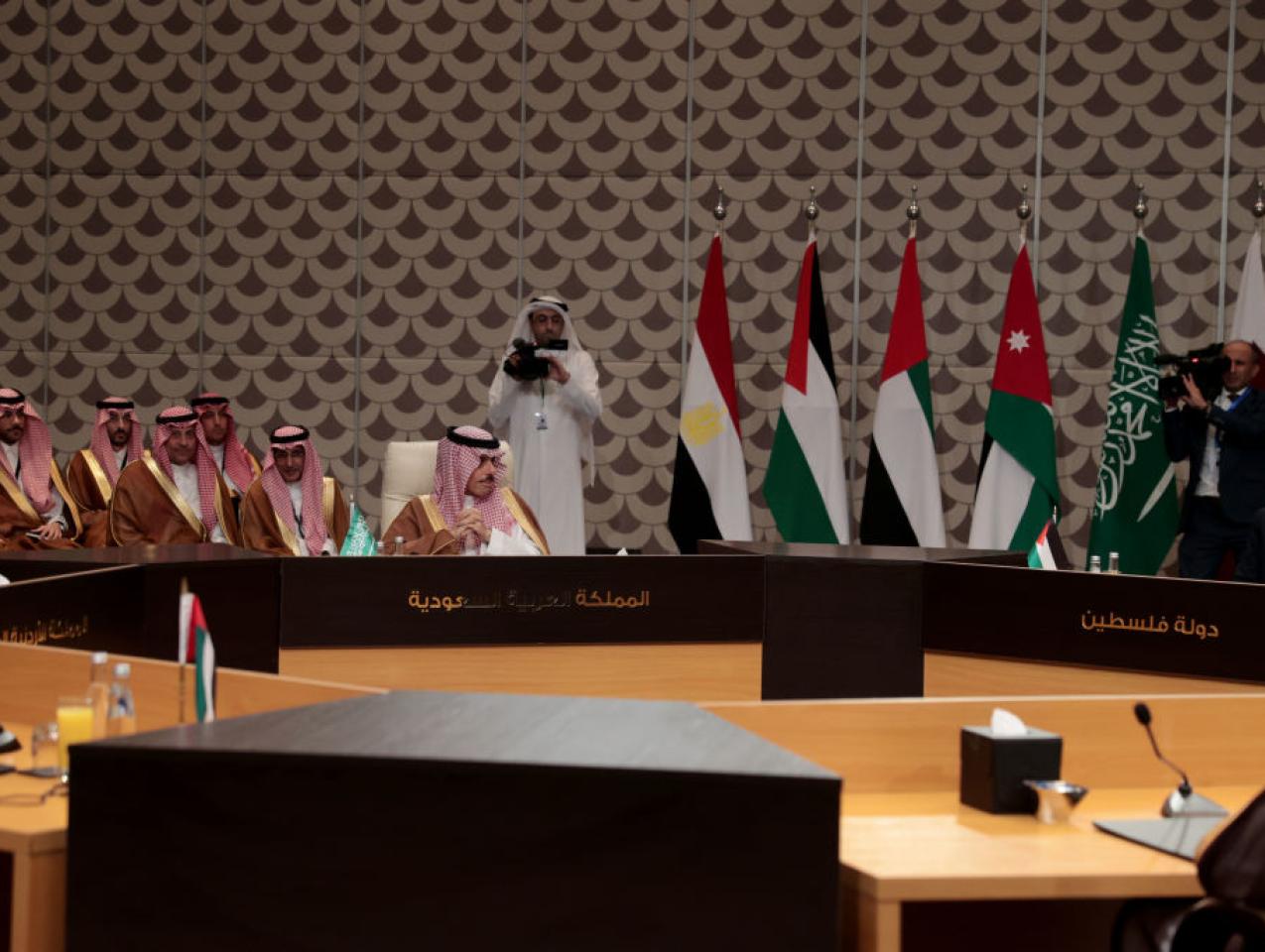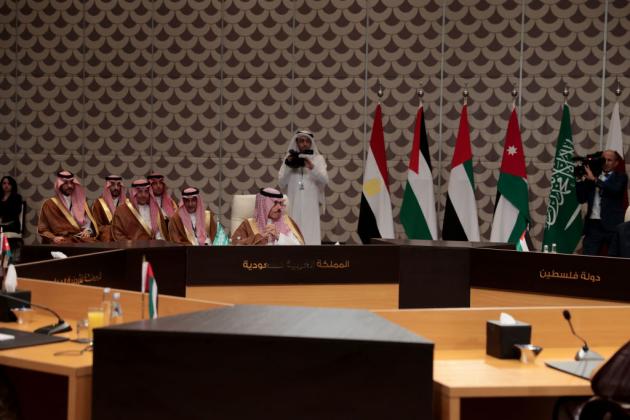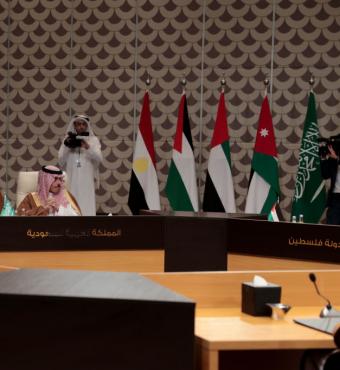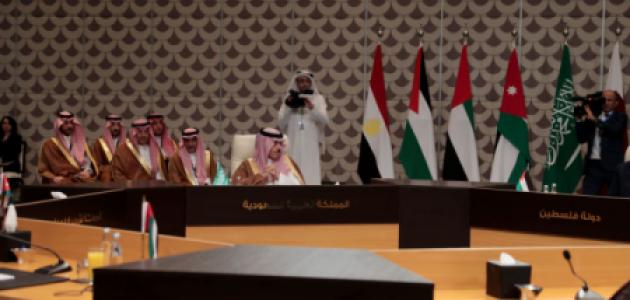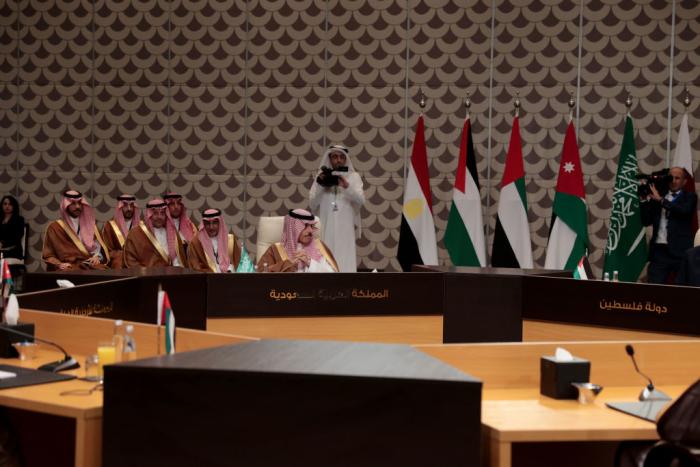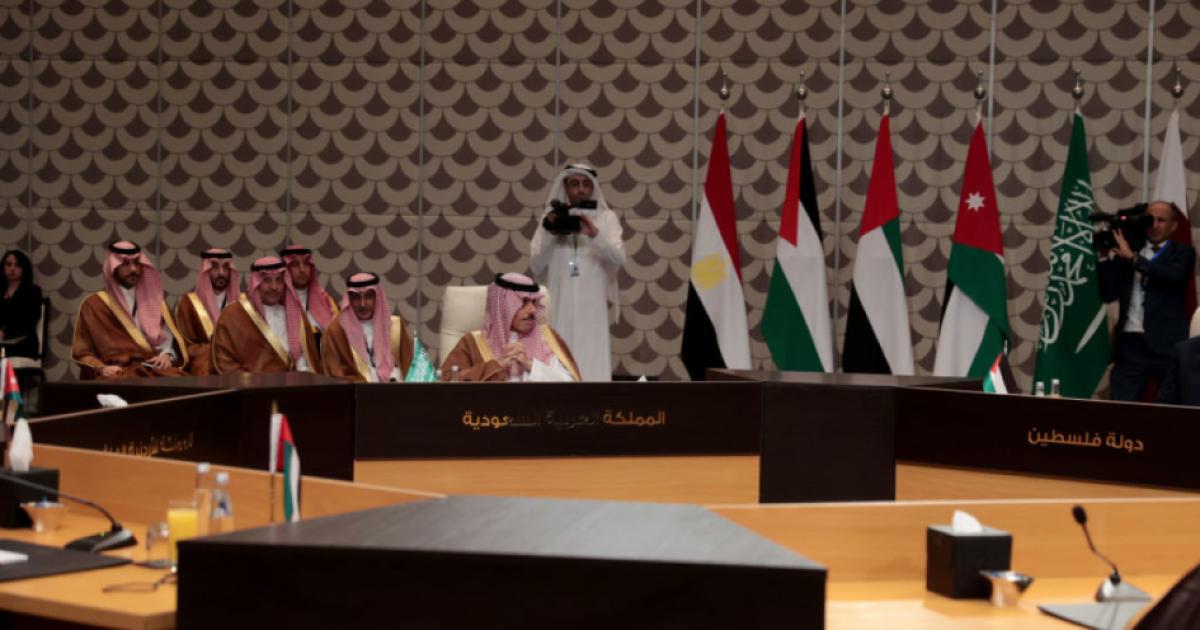Hamas’s October 7 terrorist attacks were a collective shock and trauma for Israel. More than 1,200 Israelis were killed, thousands were injured, and more than 240 hostages were taken into Gaza. In the eighth week since the attacks, Israel’s ground offensive into Gaza has delivered results. Israeli forces have dramatically reduced the number of rockets and missiles Hamas has fired into Israel. Israeli ground forces have methodically destroyed Hamas’s network of tunnels and underground military infrastructure in northern Gaza. The Israeli military operation has also displaced more than half of Gaza’s 2.2 million people and led to reports of more than 14,000 killed and 30,000 injured.
Regional leaders have responded to Israel’s military advance by convening several high-profile diplomatic events in recent weeks. The regional statecraft has focused on four overlapping issues: Applying pressure on Israel to agree to a ceasefire, both permanent and temporary; delivering humanitarian aid to Gaza; releasing the Israeli hostages held in Gaza; and planning for post-war governance in Gaza. In practice, these aims have been pursued using both diplomacy and force.
On October 7, Mohammed Deif, the commander of Hamas’s military wing, called on the Iranian-led “Islamic resistance” to join Hamas in its war on Israel. In a November 5 meeting, Iran’s supreme leader, Ali Khamenei, reportedly told Hamas’s leader Ismail Haniyeh that Iran would not directly intervene in the war. Iran’s partners, principally Hizballah but also the Houthis in Yemen and the Iranian-backed Shi‘i militias in Iraq, have repeatedly attacked Israel and U.S. forces in Iraq and Syria since October 7. But these escalating attacks have fallen short of Hamas’s expectations. On November 16, the commander of the Iranian Revolutionary Guards Qods Force (IRGC-QF), Esmail Qaani, published a letter he sent to Hamas’s Mohammed Deif, stating that Iran would do “whatever it takes” to prevent Israel from achieving its goals in Gaza. The mixed messages coming from Tehran, as well as Hizballah in Beirut, raise the question of how far Iran and its partners are willing to go to protect Hamas.
Iran’s Compellence
Since October 7, Iran and its partners, principally but not only Hizballah, have sought to limit the scale of Israel’s military operation against Hamas through verbal warnings (indistinguishable from veiled threats) and steady, low-level attacks on Israel’s borders. These attempts to compel Israeli restraint have also included approximately 90 attempted attacks on U.S. forces based in Iraq and Syria. Iran is also trying to compel the U.S. to impose restraint on Israel’s operation in Gaza. Iran would like to prevent the destruction of Hamas without sacrificing or diminishing Hizballah in Lebanon or Syria. Destroying Hamas’s ability to rule in Gaza is one of Israel’s three war objectives, which also include destroying Hamas’s military infrastructure and leadership in Gaza and returning the hostages.
As Israeli forces have successfully advanced into northern Gaza during the past three weeks, the pace and intensity of cross-border attacks on Israel’s northern and southern borders have increased. Hizballah (and indirectly Iran) are using steady, low-level commando military action and the implied threat of escalation to persuade Israel not to destroy Hamas. The Houthis in Yemen have also attacked Israel, launching drones and cruise and ballistic missiles at southern Israel from more than 1,000 kilometers away.
On October 14, Iranian Foreign Minister Hossein Amir-Abdollahian passed a message to Israel through the UN’s envoy to the Middle East, Tor Wennesland, in Beirut. Amir-Abdollahian was reported to have stated that Iran does not want a regional war and would be willing to help release the civilian hostages held in Gaza. Yet Amir-Abdollahian also said that Iran had red lines, and that an extended Israeli military operation and ground invasion into Gaza would prompt an Iranian response. Two days later after returning to Iran, Amir-Abdollahian said if Israeli “war crimes against Palestinians continue,” the “axis of resistance” would open “multiple fronts” against Israel. A few days later, on October 22, Amir-Abdollahian issued another explicit warning, stating that if the U.S. and Israel didn’t end the military operation in Gaza, “anything is possible at any moment and the region will go out of control.” During a speech delivered to the United Nations General Assembly in New York on October 28, Amir-Abdollahian told the U.S. that it would not be spared if the Israeli operation in Gaza continued. On October 30, Israel’s ground invasion into northern Gaza began.
Over the past five weeks, Hizballah forces have launched more than 165 low-level attacks on Israel’s northern border defenses and communities. Between October 16 and October 22, 42 communities in northern Israel, including Kiryat Shmonah, a city of more than 20,000, were evacuated. Israel, for its part, has carried out hundreds of preemptive and retaliatory strikes on Hizballah’s Radwan commando forces in Lebanon. Yet over the past three weeks, the geographic scope of Hizballah’s attacks has expanded beyond the northern border, with missiles landing near Acre and Haifa, which are relatively large Israeli cities. Israel has in turn ventured deeper into Lebanon, carrying out drone strikes against Iranian-made surface-to-air missile launchers in Zahrani some 45 kilometers from the border.
Hizballah leader Hassan Nasrallah, in his Martyr’s Day speech on November 10, promised that resistance fighters would continue to fight until Israel is destroyed. In response, Israeli Defense Minister Yoav Gallant threatened that “what we are doing in Gaza we know how to do in Beirut.” As the rhetoric and fighting on the ground have escalated, so too has the risk of a high-casualty miscalculation.
On November 9, a drone launched from Syrian territory struck an elementary school in Eilat, at the southern tip of Israel. There were 37 kindergarten students in the building, but nobody was seriously injured in the attack. On November 12, an Israeli electric company truck was hit by a Hizballah anti-tank missile, killing one civilian and seriously injuring several others. On November 23, Hizballah launched more than 80 rockets and fired artillery into northern Israel.
It does not appear that Israel is permitting Hizballah’s behavior to shape its decision-making on Gaza. The Israeli consensus appears to be that despite growing escalation, Israel is practicing strategic restraint and sequencing its military operations rather than attempting to fight on two fronts at once. The Biden administration is urging restraint and passing messages to both Israel and Iran with the aim of preventing unanticipated escalation that would broaden the conflict beyond Gaza. Iran’s foreign minister, Amir-Abdollahian, recently told Qatari Prime Minister/Foreign Minister Sheikh Mohammed bin Abdulrahman Al Thani that while Iran does not want a wider war, Israeli and American actions have made an expansion of the war in Gaza “inevitable.” A similar message was conveyed to Washington through a Swiss back channel.
Negotiations
Israel delayed its ground operations in Gaza for nearly two weeks, ostensibly to allow negotiators more time to strike a deal that would have freed the hostages. Qatari mediation played an important role in facilitating Hamas’s decision to release four hostages during this period without receiving anything in return from Israel, but negotiators failed to strike a larger deal to release the remaining hostages.
Following the start of Israel’s ground offensive into Gaza at the end of October, Israeli officials traveled to Doha and Cairo to negotiate for the return of the remaining 239 hostages. These negotiations with Hamas have been conducted through Qatari mediation with Egyptian support. On November 13, David Ignatius, a senior columnist at The Washington Post, disclosed that the two sides were on the verge of a deal to exchange 120 Palestinian women and children imprisoned in Israel for 70 of the abducted Israeli women and children held in Gaza. The negotiations were conducted by the head of the CIA, William J. Burns, the head of the Mossad, David Barnea, and Qatari Prime Minister/Foreign Minister Sheikh Mohammed Al Thani on behalf of Hamas’s leadership. The deal was reported to involve a five-day cease-fire to allow for the prisoners to be exchanged. A few days after Ignatius’s column, Israeli media reported that Israel objected to a deal that would have separated freed children but left their mothers in captivity.
On November 17, U.S. President Joe Biden spoke to Qatar’s ruler, Tamim bin Hamad Al Thani, and reminded him of the “urgent need” to secure the release of all of the hostages “without further delay.” Late on November 18, The Washington Post reported that Israel and Hamas, through Qatari mediation, had reached a tentative deal that called for a four-day “pause” (ha-fuga in Hebrew) in Israel’s military operation, during which 50 hostages would be exchanged for 150 Palestinian women and minors held in Israeli prisons. Hamas would release at least 10 hostages each day of the “pause,” with a corresponding number of Palestinian prisoners to be released by Israel. As part of the deal, Israel agreed to allow 200 trucks of humanitarian aid per day to enter Gaza via Egypt’s Rafah Crossing. The first three groups of Israeli hostages were successfully released between November 24 and November 26, with the final group of ten hostages expected to be released on November 27. On the afternoon of November 25, both Cairo and Doha played important roles in resolving a temporary crisis when Hamas delayed the release of the second group of hostages. As of November 28, there were still 173 hostages in captivity, including 6 children and 45 women.
Qatar’s diplomacy highlights the controversial role it plays as the host and financier of Hamas’s political leadership. Qatar has hosted Hamas’s top leadership since 2012, when it relocated from Damascus during the Syrian civil war. Qatar’s relationship with Hamas has allowed it to effectively mediate between Israel and the group. Qatar plays an important role as a hub for Hamas’s international financial network, which receives important assistance from Iran and includes nodes in Algeria and Turkey. Israeli officials believe that Qatar’s financial support for Hamas provides it with leverage to apply pressure on Hamas’s leadership, and not just to mediate between the two sides. While Qatar has courted the Western media and sought to highlight its mediation role in the hostage diplomacy, Egypt has played an equally important role, working in tandem with Doha, but remains out of the spotlight.
Despite the recent humanitarian pause, Israel has sought to minimize the hostage diplomacy’s effects on the pace, scope, and intensity of the military operation in Gaza. The Israeli leadership believes that it was an unyielding application of force since the end of October that convinced Hamas to release the hostages. For this reason, among others, Israel has opposed calls for a “ceasefire,” a term which suggests not only a cessation of hostilities but also a parallel process of negotiations to end the current conflict. Israel views active military pressure on Hamas as a vital instrument to ultimately free all of the hostages.
Hamas, for its part, will undoubtedly use the pause to reorganize its military forces. Israel has sought to limit the length of the current pause to deny Hamas additional time to regroup and reconstitute its rocket- and missile-launching capacity.
Israel will also have to contend with the possibility that Hamas will use the current pause to generate diplomatic pressure on Israel to extend it indefinitely, combining negotiations for the release of the remaining hostages with ceasefire talks. In other words, Israel understands that it will be hard to regain the battlefield momentum following an extended pause. Israeli leaders have been at pains to emphasize that they will resume the military operation in Gaza, and that “it is a not a matter of whether but when” Israel moves into southern Gaza and targets the Hamas stronghold of Khan Younis. Nevertheless, on November 26, President Biden signaled that he would like to see the pause extended in order to free more hostages (a “more for more” arrangement), and later in the evening Hamas announced that it was seeking to extend the pause. On November 27, the two sides agreed to a two-day extension to the pause to allow for an additional exchange of ten Israeli hostages for thirty additional Palestinian prisoners each day.
Summitry
On November 11, Saudi Arabia hosted an “Extraordinary Arab-Islamic Summit” in Riyadh to discuss the war in Gaza. The summit included the heads of state of nearly all the major Arab and Muslim countries, bringing Arab League members together with Organization of Islamic Cooperation (OIC) countries after the Arab League failed to come to an agreement on its posture towards Israel.
The summit produced a strongly-worded closing statement consisting of 31 clauses, but there were no clear binding resolutions or practical steps due to disagreements between regional powers on four major issues. First, while there was agreement that the fighting should stop immediately, there appeared to be disagreement about how the fighting should be stopped. For example, the closing statement called on the foreign ministers of Saudi Arabia, Jordan, Egypt, Qatar, Turkey, Indonesia, Nigeria, and Palestine, as well as other interested parties, “to initiate immediate action” to “stop the war on Gaza,” as well as to apply pressure to “launch a serious and real political process to achieve lasting and comprehensive peace.” The statement also called for weapons and munitions exports to Israel to be stopped. At the same time, the statement called on participants to “take any deterrent measures [emphasis added] to stop the crimes of the colonial occupation authorities against humanity.” On the one hand, then, the closing statement is calling for a political process for peace. On the other, however, its reference to deterrent measures suggests that using force is legitimate to stop Israel’s operation in Gaza. The use of force to apply pressure on Israel would be consistent with Iran’s behavior to date.
Second, while there was consensus on criticizing and condemning Israel’s military operation, there was disagreement about whether and how to punish and delegitimize Israel. The statement’s language focused on condemning Israeli aggression in Gaza and calling for Israeli “war crimes” to be investigated by the International Criminal Court (ICC). However, some of the summit’s participants sought to punish Israel further. In the preparatory work leading up to the summit, Iraq, Lebanon, Tunisia, Syria, and Algeria proposed severing economic relations with Israel and imposing economic sanctions, and there were proposals at the summit that called for a diplomatic break with the country. Jordan and Turkey have already withdrawn their representatives from Israel in support of their demand for a ceasefire. Iran, working with Algeria, led an unsuccessful effort to advance several punitive measures directed at Israel, including cutting diplomatic ties with the country and designating the Israeli military a “terrorist organization.” The Gulf States, including Qatar, Egypt and Jordan rejected the proposals.
Third, there was public disagreement about the nature of the solution for the Israeli-Palestinian conflict. This disagreement reflects the large gap between how the conservative Arab states (such as Egypt, Jordan, Morocco, Bahrain, the United Arab Emirates, and Saudi Arabia) and how Iran and those aligned with it view Israel. The conservative Arab states have come to accept Israel as part of the region, while at the same time insisting the Palestinians’ demand for statehood be addressed. The secretary-general of the Arab League, Ahmed Aboul Gheit, who is a former foreign minister of Egypt, argued that the future of Gaza can’t be addressed separately from the West Bank and a future Palestinian state within the 1967 borders with East Jerusalem as its capital. He called for an international peace conference to change the public focus from the war to a political settlement. Iran, for its part, refused to endorse a two-state solution, arguing that Israel should not exist at all. In the days following the summit, Iran’s foreign ministry issued a public statement with four “reservations” about the summit’s closing statement. The reservations included the statement’s references to a two-state solution, the 1967 borders, the Arab Peace Initiative of 2002, and its affirmation of the Palestine Liberation Organization (PLO) as the sole legitimate representative of the Palestinian people.
Fourth, and most importantly, while there was consensus at the summit on the need for a ceasefire in Gaza, the fate of Hamas stood out as a major source of disagreement. The UAE and Bahrain reportedly refused to include wording in the closing statement that referred to a “right to resistance,” which was backed by Iran and proposed by Tunisia, Iraq, and Syria. While Iran and its allies were clearly opposed to Israel’s aim of destroying Hamas, some of the Gulf states appeared to favor Hamas’s removal as the governing authority in Gaza. Egypt, for its part, occupied a unique position. According to a report on the summit, Egypt believes the goal of destroying Hamas is unrealistic, and therefore it opposed Gulf-led side discussions at the summit that advocated using the war to permanently end Hamas’s rule in Gaza. Egypt, which shares a border with Gaza, fears a power vacuum that would lead to intra-Palestinian armed conflict and long-term instability in Gaza. Further, Egypt has coordinated with Hamas on preserving security and stability in northern Sinai. Egypt rejected pressure at the summit to commit to keeping the Rafah border crossing unconditionally open without coordinating with Israel. Such a step would give Hamas an important lifeline. Egyptian sources emphasized that Rafah remained open for humanitarian purposes, but cutting Israel out of the administration of the crossing was impractical and would only lead to Israeli attacks on the border area near the Rafah Crossing.
Avoiding Regional War and Planning for the “Day After”
Israel has relied on the U.S. to help ensure that it has the time and freedom of action it needs to achieve its war objectives. Complicating the U.S. position is the lack of any clarity over what comes next in Gaza.
In the week before the November 10 Riyadh summit, U.S. Secretary of State Antony Blinken made stops in Jerusalem, Nicosia, Amman, Ramallah, Ankara, and Baghdad. His efforts reportedly focused on facilitating humanitarian relief for Gazan citizens, arranging for humanitarian “pauses” in the fighting, and helping foreign citizens leave Gaza. Blinken faced Arab leaders who pressed him for a full and immediate ceasefire, which Blinken resisted, arguing that it would allow Hamas to regroup and attack again. His most challenging discussions focused on trying to prepare the ground for what would follow in Gaza when the war is over, the so-called “day after” scenarios. He was confronted by Arab leaders who were reluctant to discuss what would follow the war until there was a ceasefire.
According to an Israeli report, Blinken’s conversations with Arab leaders were frustrated by Israel’s reluctance to discuss who would govern Gaza if and when Israel destroys Hamas. Israeli Prime Minister Benjamin Netanyahu’s mixed messages regarding Israel’s intentions in a post-Hamas Gaza have also raised concerns in the Biden administration. Netanyahu said that “there will be no further threat from the Gaza Strip on Israel, and to ensure that, for as long as necessary, the IDF will control Gaza security to prevent terror from there.” A few days later, Netanyahu attempted to clarify Israel’s position when he said that Israel “does not seek to conquer, occupy, or govern Gaza after its war against Hamas.” Blinken’s efforts to enlist Arab partners in stabilizing Gaza in the aftermath of the war have also been hindered by Netanyahu’s public resistance to the Palestinian Authority (PA) as a potential partner in governing Gaza after the war. This has raised concerns among Arab leaders, many of whom fear a post-Hamas vacuum in Gaza.
Arab leaders also view Netanyahu’s reluctance to consider a role for the Palestinian Authority in Gaza as a thinly-veiled attempt to sustain the conflict’s status quo and avoid a two-state solution. Writing in The Washington Post on November 15, King Abdullah of Jordan rhetorically asked, “Are there any realistic alternatives to a two-state solution?” He added, “It is hard to imagine any. A one-state solution would force Israel’s identity to accommodate competing national identities. A no-state solution would deny Palestinian rights and dignity.” George Abed, former governor of the Palestinian Monetary Authority, wrote that the Palestinians also have to accept mutual recognition and a two-state solution, but argued that “Hamas can be neutralized as a military threat, and likely diminished as a political force, only by a vote of the Palestinian people.” Abed framed that outcome as part of a medium-to-long term process that transforms the governance structure in the West Bank and Gaza with the help of the U.N., the U.S., and unnamed “regional partners.”
The primary issue dividing the regional powers is the fate of Hamas. It appears that Saudi Arabia and the UAE see a window of opportunity to remove Hamas from Gaza. This is consistent with their hostility to the Muslim Brotherhood and Hamas’s radical ideology. Qatar, Egypt, and Turkey are for different reasons opposed to Hamas’s destruction. Qatar’s prime minister/foreign minister, Sheikh Mohammed Al Thani, recently declared that for now, “Our only plan is to stop the war.”
Israel, for its part, is focused on saving the abducted Israelis and destroying Hamas’s political rule and military machine in Gaza. Maintaining U.S. goodwill and support will be vital for Israel to have the time and international legitimacy necessary to achieve these objectives. To this end, Israel should clearly state that it has no intention to permanently expel, displace, or relocate Gaza’s population. It should also clearly explain the process and conditions for delivering more humanitarian aid and medical relief to the Gazan population as the military operation moves on to southern Gaza, particularly if Israel is indeed planning on establishing a vast tent-city for refugees at al-Mawasi in the southwest corner of Gaza. If plans to allow for a humanitarian maritime-corridor to Gaza through Cyprus are still in play, these too should be clearly outlined to the international community.
Israel’s political leadership must continue to listen carefully to its current and future regional partners and use discreet and reliable back channels to consult with them on its future plans for a Hamas-free Gaza. Amos Yadlin, a former head of Israeli military intelligence, and Udi Evental, a retired colonel in the IDF, recently argued that Israel “should initiate a dialogue with Arab countries and international partners to formulate a plan for the future governance of Gaza.” They view “the most promising approach” to be the establishment of an interim administration led by the United States and Israel’s peace partners until the Palestinian Authority is ready to assume responsibility for Gaza.
Israel has strong incentives to begin this discreet dialogue as soon as possible. The India-Middle East-Europe Economic Corridor (IMEC) was announced in September at the G20 summit, in parallel with the U.S.-led talks of normalization between Israel and Saudi Arabia. Israel will need Jordan and Saudi Arabia’s cooperation to make the western half of IMEC a reality. Saudi funds and Egyptian security coordination will be needed to rebuild and deradicalize Gaza. For the time being, Israeli collective trauma and the divisive domestic politics leading up to the October 7 attacks appear to be an obstacle to taking bolder steps. However, a successful U.S.-led dialogue on the future of Gaza could be a step on the way to a broader conversation about how to create a viable political horizon between Israel and the Palestinians.
Iran’s efforts to compel Israel to limit its war in Gaza run the risk of miscalculation. An errant attack by Iran or one of its partners on either Israel or U.S. forces could lead to unintended dramatic escalation and a broader war. As recent reports (see here and here) have documented, Hamas has sought to provoke a broader war between Israel and the Arab-Muslim world.
A critical unanswered question is whether Iran intends to answer Hamas’s call to arms. The conventional wisdom is that Iran is unwilling to sacrifice the pillar of its “forward defense” strategy, Hizballah, to ensure Hamas’s survival. However, Israeli officials will be more cautious about drawing hard conclusions about Iran and Hizballah’s intentions in the aftermath of October 7. While Palestinian Islamic Jihad offers Iran an alternative client in Gaza, it is not still clear whether Iran feels it can afford to see Hamas destroyed. Therefore, while it is undoubtedly important for Israel to carefully consider “the day after” in Gaza, there are still considerable dangers that lie ahead in the days before the day after, and they too must be carefully addressed. A regional war between Israel and Iran and its partners would vouchsafe Hamas the pyrrhic victory it has thus far been denied.
Brandon Friedman is the Director of Research and a Senior Research Fellow at the Moshe Dayan Center (MDC) for Middle Eastern and African Studies, Tel Aviv University.







